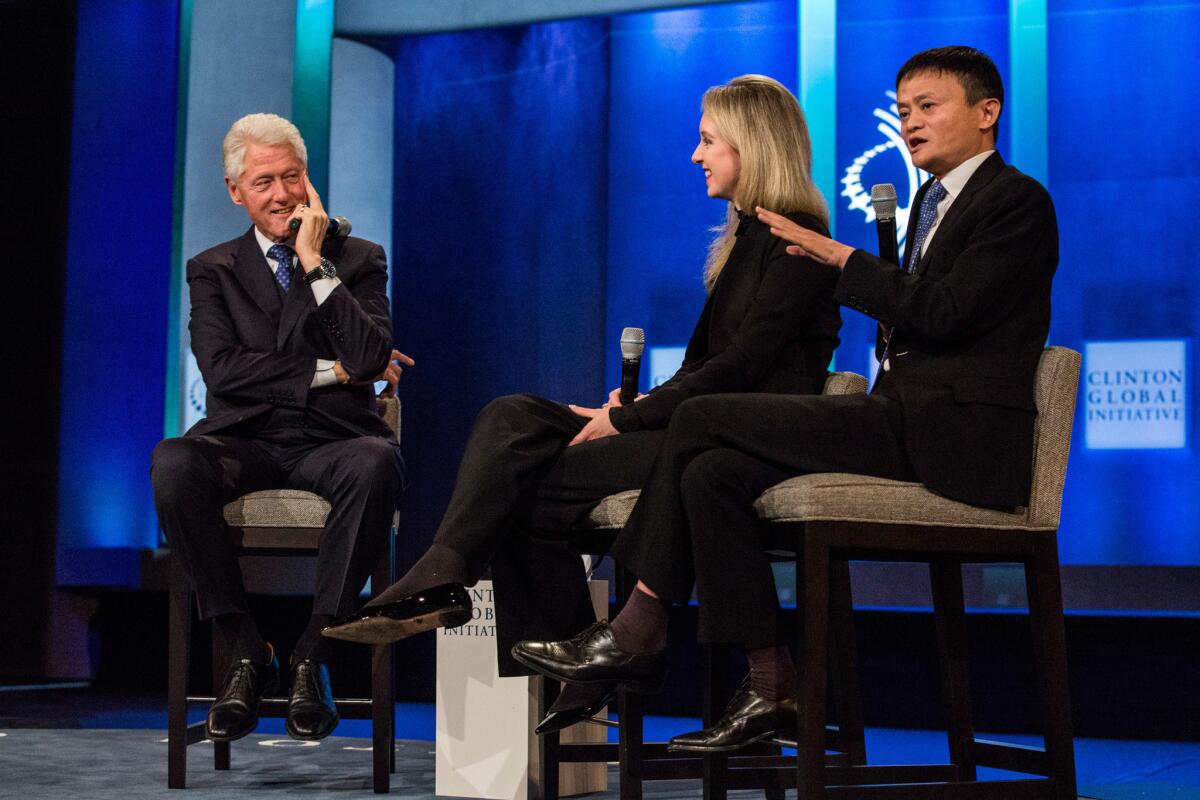Column: The Silicon Valley investment bubble starts to deflate

Put the excitement on hold for a moment: Elizabeth Holmes of beleaguered startup Theranos was flanked by former President Bill Clinton and Jack Ma, chairman of Alibaba Group, at a recent event sponsored by the Clinton Global Initiative.
- Share via
Bubbles are made to be popped, and evidence is mounting that Silicon Valley’s most recent bubbles, among them private investments in biotech and initial public offerings in several sectors, are leaking air.
The investment landscape in technology is so varied that it’s hard to come up with a single metric. But even venture investors are pointing to some worrisome signals. Among them are developments that point to investors becoming a lot more choosy about how much they put into companies that are still more about aspirational rhetoric than about bringing out a marketable product.
I’m of the belief there’s an 80% chance we’ve tipped...We’ve moved from everything’s rosy and we’re starting to see cracks.
— Venture investor Bill Gurley
Exhibit A on this score may be Theranos, the Palo Alto biotech company whose claims for its blood-testing technology were exploded by articles last week in the Wall Street Journal. Theranos may yet make good on its claims to transform healthcare, but the possibility that it has been concealing problems behind the scrim of private-company secrecy could make investors more skittish or their due diligence more, well, diligent. Either development will lower values across the sector.
“It is easier to conceal weaknesses, present an aura of invincibility and confound investors as a private company that can escape by making fewer disclosures than as a publicly traded one,” wrote Michael Moritz, chairman of the venture firm Sequoia Capital, in the Financial Times last week.
Among the other top VCs sounding caution, or even alarm, is Bill Gurley, the veteran general partner of Benchmark Capital. At a conference last month he reckoned that the current venture cycle may have passed its peak. “I’m of the belief there’s an 80% chance we’ve tipped,” he said, projecting pain ahead: “There’s no soft landings. There’s boom-bust periods — ’01 and ’09 were tragic and really hard to execute through....We’ve moved from everything’s rosy and we’re starting to see cracks.”

A recent survey by Reuters documented a distinct fall-off in valuation increases as venture-backed companies move into the public market via IPOs. Among companies in the Reuters survey that recorded higher values, the median increase in 2014 was 61%. This year, it’s about 32%.
Investors are taking a close look at “unicorns,” companies with valuations over $1 billion--think Uber, with a purported valuation of more than $50 billion, and Airbnb, at $25 billion. Those valuations are typically based on the contributions of equity investors, which come to only a fraction of the valuations and can be very squishy. Theranos, which ranked 13th on a recent unicorn list prepared by Dow Jones VentureSource, was valued at $9 billion last year based on equity investments of $400 million.
A handful of these companies may justify their backers’ lofty expectations, Moritz observed. But many others seem based on “the flimsiest of edifices.”
Biotech is facing particular risks, analysts say. Stock market turmoil, as has reigned in recent months, is never comforting for IPO planners, and the recent public uproar over drug pricing by entrepreneurial pharmaceutical firms hasn’t made things more inviting.
Just in the last month, according to a roundup by Fierce Biotech, Strongbridge Biopharma raised $25 million in an IPO, far below the $86 million it had once hoped for, and several other closely followed biotechs came to market at 30% to 40% below their earlier expectations.
Not all the indicators are flashing red. In its most recent venture capital survey (covering the second quarter of 2015), the intellectual property law firm Fenwick & West found that up rounds--investment rounds at higher valuations than the prior round--were beating down rounds 83% to 8%, with 9% flat. The 75-percentage-point difference was the largest since the firm started calculating the ratio at the beginning of 2002. Software, digital media and life sciences were the three healthiest sectors.
Yet there’s no doubt that Silicon Valley investors are sensing a definite chill. The real question is whether they’ll react by pulling back more than they should. Gurley, for all his talk of a hard landing, also observed that investors and entrepreneurs have been misled by the heady environment of recent years, forgetting that cycles are inevitable.
“When it turns it’ll feel more cataclysmic to people than it should,” he said, “because a lot of entrepreneurs only have a three-year memory window.”
Keep up to date with the Economy Hub. Follow @hiltzikm on Twitter, see our Facebook page, or email [email protected].
More to Read
Inside the business of entertainment
The Wide Shot brings you news, analysis and insights on everything from streaming wars to production — and what it all means for the future.
You may occasionally receive promotional content from the Los Angeles Times.











